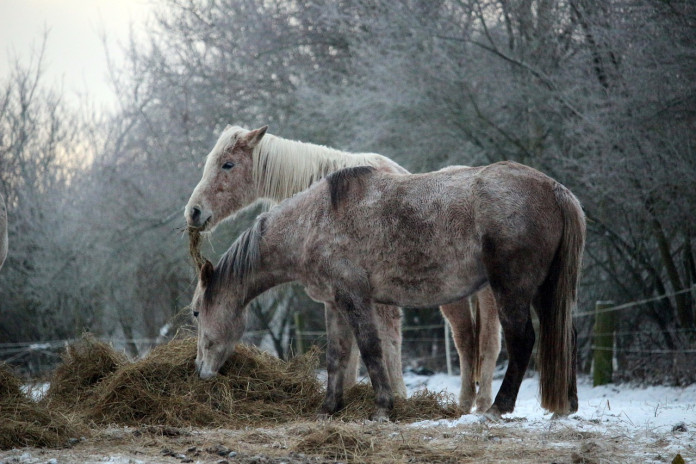As the new year begins, most Ohio graziers are probably feeding a good portion of hay as a part of their animals’ daily ration.
Even if there is a supply of stockpiled forage available, we tend to make hay available just in case they need a little extra. It is likely that grain is also part of that daily ration.
How do you know how much hay, grain, and pasture they need? No one wants to leave their animals hungry, nor do we want to waste time or money with unnecessary feeding.
Hay test
Figuring out the balance can seem like a guessing game, but a great place to start is with a hay test.
Testing the hay you are feeding is well worth the price of sample analysis. Collecting a sample is not complicated and typically results are available from the lab within two weeks.
You can acquire the tools and kits on your own to submit samples, or you can find them at most county Extension offices and often from Soil and Water Conservation Districts.
Ag co-ops usually offer sample analysis services as well.
Whoever you chose to go through, be sure to select the analysis package that will give you the detailed results you desire.
The package that costs the least will probably still leave you guessing.
My typical suggestion is to select a test that will give you values for moisture, crude protein (CP), acid detergent fiber (ADF), neutral detergent fiber (NDF), total digestible nutrients (TDN), and Relative Feed Value (RFV).
Interpret the results
Once you receive the results of your analysis, the challenge of interpreting the values arises.
How do you know what values are good or bad? Your hay test results will list values on a dry matter (DM) and an as-fed basis.
Nutrients will appear to be higher for DM basis, because all the remaining water (percent moisture) in the hay has been factored out.
For CP, values of 8 percent or greater are desired. For ADF, lower is better. Increased ADF values equal decreased digestibility.
Neutral detergent fiber is the amount of total fiber in the sample, which is typically above 60 percent for grasses and above 45 percent for legumes. As NDF increases, animal intake generally decreases.
For TDN and RFV, the greater the values, the more desirable the forage.
Compare
These values are useful for comparing your forage to other feeds available on the market. Once you have these values compiled you can start formulating rations based on nutritional values of the hay.
First, consider the needs of your animal. Stage of life, current weight, desired weight, and environmental conditions are all important factors.
For the sake of an example, let’s assume we are developing a ration for a growing Angus heifer. Currently, she weighs about 800 pounds and we want her to gain about 200 pounds by the end of March.
Ideally, we would like her to gain about 2 pounds per day.
Test example
Now, let’s take a look at a hay test example and assume it is for our hay.
Field 1 contains fescue hay with 15.91 percent moisture, 84.09 percent dry matter, 12.53 percent crude protein, 37.79 percent fiber ADF, 72.03 percent fiber NDF, 59 percent digestible nutrients and 77 percent relative feed value.
According to the information from our hay sample and the recommendations from the National Research Council for beef cows, we could expect this animal to eat about 21 pounds of hay daily and gain 1.75 pounds per day, coming in just short of our goal.
This hay should be adequate for meeting the heifer’s energy needs as her main feedstuff.
If we think it is worth the investment, supplementing with some high energy, high protein grain could help reach our desired average daily gain (ADG).
Soybean meal has an average of about 44 percent CP. Supplementing 1-2 pounds of soybean meal (a pelleted form will increase animal intake) should provide the additional nutrition to reach our goal.
Whole shell corn is about 9 percent CP, which is lower than the CP content of our hay. Unless we are concerned about our hay supply, supplementing corn may not be significantly beneficial.
Results will vary
This was just one example of how a hay test can help with the development of livestock rations. Recommendations will vary depending on types of hay, time of year, animal species, stage of life, and production goals.
With so much possible variation, every little bit of knowledge we can secure is helpful for developing production goals and expectations.
Hay tests may not reveal ideal results and they can vary drastically between cuttings. That is the reality of attempting to manage nature, but we do the best we can.
As you look ahead to the next growing season and putting up hay once again, do everything you can to efficiently improve forage quality and nutritive value of your stored resources.
The better the nutritive value of your forage, the less you will need to supplement and the more money you can keep in your pocket.
With that, I will leave you with a quote from Jim Rohn: “Success is neither magical nor mysterious. Success is the natural consequence of consistently applying the basic fundamentals.”
Happy New Year. My best wishes to you and yours for 2017.













